HaveYouBeenHere? The Prehistoric Cliffs of Walton, Essex
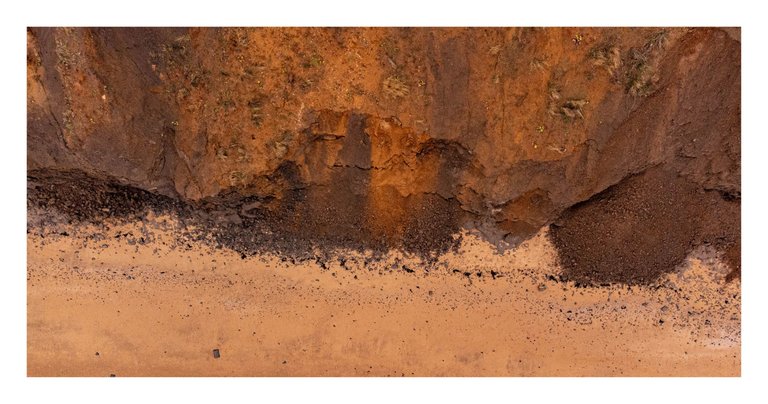
To the far east of England sits the small town of Walton. Its streets very much empty and decayed, featuring faint remnants of a different era in which the British public flocked to the coastal towns in search of sun, beaches, and activities prior to the ease of cheap and increasingly safe travel by air. A walk through its streets on a Wednesday morning shows the struggles of independent businesses in a dead environment, and its buildings coated in the bleeding of orange rust. The many faces of those remaining seem to reflect the dated, roughed look of this place.
Here in Walton you see history. The past that was left, ignored, and ultimately faded away, leaving behind the ghosts of civilisation. Its decay is everwhere, but its most interesting area of decay and history is but a short walk away: The Naze.

Moments away from civilisation reveals an area in which the land of England meets the sea it shares with both Belgium and the Netherlands. Where some of our richest elements of the past sit on its beach, waiting to be discovered.
Separating the land from the sea is a cliff as high as 70 feet, but falling victim to the test of time itself as it retreats a near 2 metres per year. This erosion is a natural occurrence as the land struggles to fight in the battle of strong weather and forces as the decades pass. These particular cliffs have led to some rather catastrophic erosion, but such destruction of this environment has revealed the world that was before our very feet walked on its beaches.

It is only from above that you gain a real understanding of this erosion. Where the land resembles a sandwich with a few bites taken out of it. The Georgian tower to the right in the image above was placed to direct ships and display the land. That tower may very well fall into the water one day, but attempts have been made below to control the water and avoid more erosion, using the rocks as a sea defence.
I remember being a child, standing dangerously close to the edge of the cliff and looking down. There were no clay deposits at the time, the erosion hadn't resulted in such slopes, either. It was a sheer drop down. The green itself was much larger. I remember a time where hundreds could fill the space with activities without being anywhere near the edge of the cliffs.
As mentioned above, however, it is these very cliffs and their erosion which is revealing much more about our past, and the ways in which our land was formed over time. But I'll get into that a bit later.
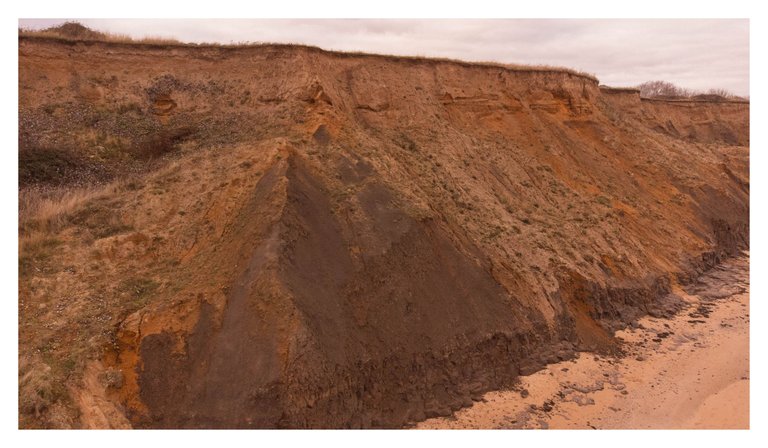
Facing the cliffs, you'll notice the diverse materials that sit inside its body. The differing colours and layers that have resulted in its formation as land over the period of several million years. Where the slumped-over London clay and red crag have not obscured the history of the cliff's face, you'll notice the many layers that run a fine line throughout the cliff's entirely along the coastline.
You'll see the beauty of volcanic formations, and even the blue tints of permafrost, still present from the last ice age, which ended sum 25,000 years ago. Looking at the face of these cliffs, you're looking back at different periods of time, each having a fundamental contribution to the formation of both our existence as humans, and the land in which we now take for granted and inhabit.
Both the red crag and the London clay -- the London clay having a history of 54 million years of age -- create a mixture of strong orange and grey which litter the sandy beach below, leading to large deposits of clay.
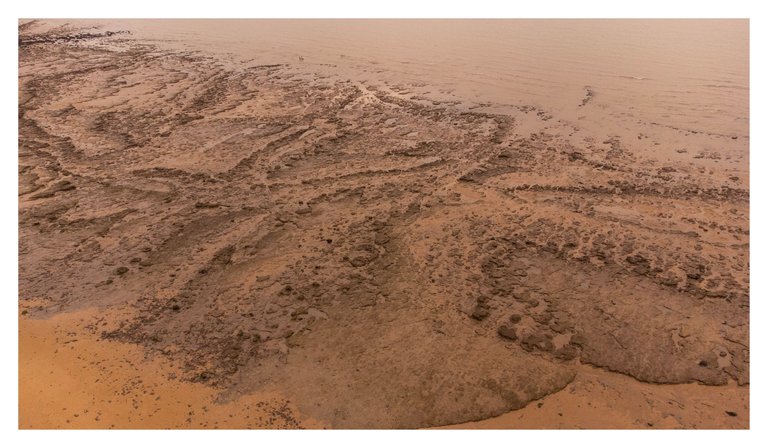
These deposits of clay take up a vast majority of the space on the beach. Which certainly was not the case as I grew up and ventured to this area. The loss of land has increased quite drastically; where now where I once stood above is simply a space that no longer exists. Where the clay from the fallen land has spilled and created deposits that form new areas of land and space for life; an event that is both sad and positive in its slow creation for more space for life to inhabit in the future.
It is here, in these clay deposits formed from the eroding cliffs, that the past truly reveals itself to you: fossils. Kept waiting for discovery in the clay of 54 million years of age is the fossilised remains of sharks, fish, mammals, and more. Where people have discovered not just giant shark teeth, but mammoth teeth larger than your hand. Where pyritised twigs scatter the beach, left from the plants and trees that stood all those many years prior.
These signs of life cover the entirety of the beach, sitting on the sand, hidden among the many stones and shells that accumulate alongside the shore. They take very little time to find, and simply require some patience and a good eye. During my time there, after many years since my last visit, I mostly flew my drone and took photographs, but I did manage to find two small teeth that belonged to a shark from many years prior -- I gave one to a child and his father who were present and looking to find some themselves, during their first visit there.
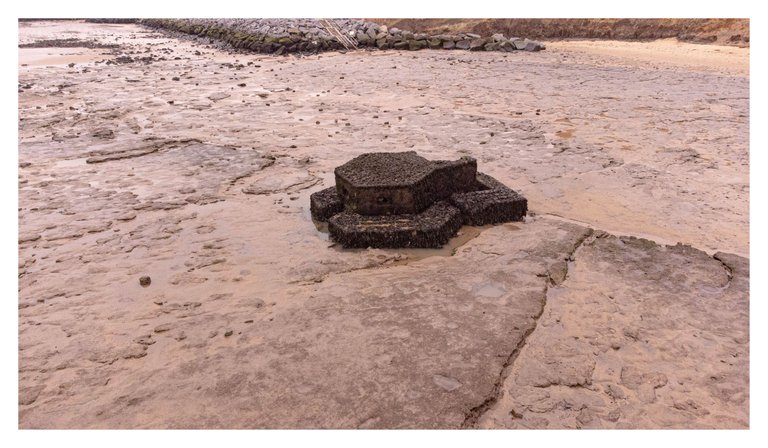
Moving forward in time, to a period a little closer to ours, you'll also find the remnants of World War 2 sitting in the London clay on the beach. Pillboxes are littered throughout England, to the point in which most people have probably seen one or two in their lives. You'll find them in coastal areas, or deep in the countryside by rivers that act like Earth's veins as they branch off into varying sizes and depth leading outward to a larger body of water.
These pillboxes that now sit on the clay, however, were once placed above, on the land. Even these have fallen victim to the erosion of the land, and have gracefully been claimed by nature, covered in seaweed and various growths as the tide sweeps in each day. Numerous pillboxes will be found in the area, some still above, kept relatively tidy as if to prepare for an invasion still. Though I have no doubts that they too will fall and be claimed by the sea in time.
I flew my drone around this area for a while, but at times I wasn't sure where I should point the camera. Or whether I should even fly at all -- I was a little nervous of the wind and the water below -- but this was mostly due to the fact that the sheer depth of this location's history was so profound. I wasn't sure whether I should stop and stare at the various layers of clay and rock that formed the cliffs, or whether I should look down in search for the fossils that are of an age that I can only comprehend by its number.
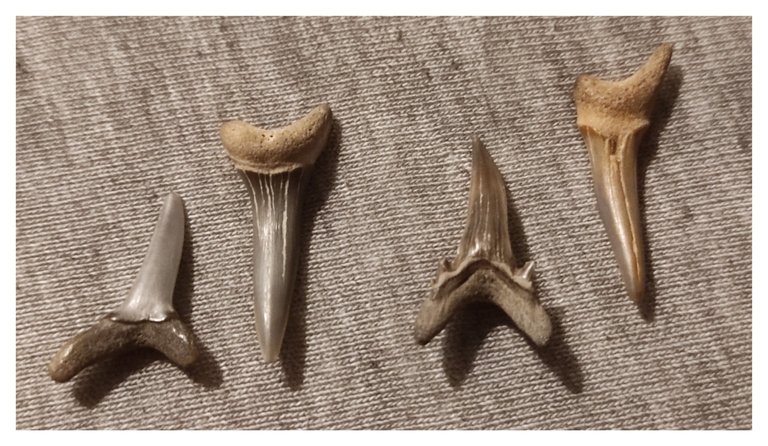
I didn't manage to find anything worthy of sharing here today, but above are some of the teeth I managed to find when I was a child at that same location. They can be as large as your thumb, and sometimes very sharp. Still, nowhere near as impressive as the megalodon teeth people have found there, big enough to cover their entire hand.
If you haven't been there before, definitely check it out sometime. But I'd certainly recommend going during spring or summer, to avoid the strong winds, rains, or simply just tide issues. It's an area so rich in history, featuring so many different significant periods of time, it's almost strange to see a location in which such differing periods of history are all visible at once, down to the very discovery of fossils by ordinary people on its land.
Congratulations, your post has been added to Pinmapple! 🎉🥳🍍
Did you know you have your own profile map?
And every post has their own map too!
Want to have your post on the map too?
I haven't been there, but now I have it on my bucket list!
It is sad to see the cliff slide, although the erosion makes it look really interesting. I will add it to my list, it is definitely worth visiting. Hopefully, we can find a bit of history too.
I would also like to mention that your writing is so beautiful, really enjoyed reading it!
You'd be surprised at just how easy it is to find fossils there. Over the decades it has grown to become an area known to those who are into that sort of thing, but sadly the erosion doesn't just pertain to the cliffs, but to the area too. Economic decline has heavily impacted the nearby area to the point where many won't bother travelling to it, especially when the weather isn't all that great in these autumn and winter months.
While I was there yesterday, finally as an adult, I did have the epiphany that it's incredibly strange how this beach is riddled with such historical depth, but just sitting on its surface each day. And so few seem to care.
Thank you! I really appreciate it. These travel and photography posts are definitely the ones I most enjoy creating. I always feel an itch to do one, but I find it quite difficult to get around as of late due to covid restrictions and issues within the travel industry. I've even recently taken a liking to the idea of having a notepad follow me around to jot down adventures and sketch moments of interest.
Your content has been voted as a part of Encouragement program. Keep up the good work!
Use Ecency daily to boost your growth on platform!
Support Ecency
Vote for new Proposal
Delegate HP and earn more
Hiya, @LivingUKTaiwan here, just swinging by to let you know that this post made it into our Honorable Mentions in Daily Travel Digest #1415.
Your post has been manually curated by the @pinmapple team. If you like what we're doing, please drop by to check out all the rest of today's great posts and consider supporting other authors like yourself and us so we can keep the project going!
Become part of our travel community:
It's a really nice looking place, and looks like it has quite a few more things than just being picturesque going for it. If you're there for a while could you not do all of the things? (using the drone to take pictures, staring at things, looking for things? XD)
It would depend on the time of year and the day. Lately it's getting dark around 3:30pm so that's not a whole lot of light in the day when it's already quite overcast and dull. Then there's the tide, which will quite quickly catch you off-guard if you're not paying much attention to it. There are two ways to enter/exit the beach, but it's quite a long beach, and the tide can quickly cut off access to both sides.
I think it would be best to go there during spring or summer rather than the middle of December. :^)
Wow I'd love to take a walk there, great post!